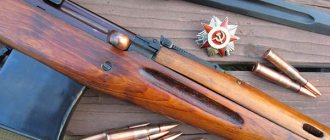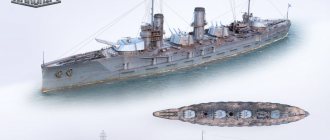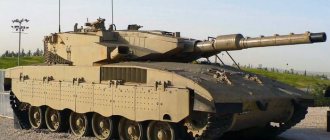On July 13, Metropolitan of Tallinn and All Estonia Evgeniy (Reshetnikov) served a litany for the crew of the M-96 submarine at the point of its destruction in the Estonian part of the Gulf of Finland. Until now, this submarine was considered missing. The day before, members of the international expedition of the Russian Geographical Society dived in the Narva Bay and reliably identified the remains of the M-96.
The search for the submarine lasted three years. They searched from two sides - Russian search engines from the “Reconnaissance and Diving Team” and the Estonian group Maxstar Explorer. The location of the death in the Narva Bay on the border of the two countries was previously established by historian Miroslav Morozov - the German Seeiegel minefield, south of Bolshoi Tyuters Island. This is a fairly large area, so the search was not successful.
op8a8891.jpg
Machine telegraph from the M-96 submarine.
Photo: “Reconnaissance and Diving Team” According to the expedition leader, director of the “Reconnaissance and Diving Team” Konstantin Bogdanov, the situation changed when Russian and Estonian researchers joined forces.
“We combined the information we had and narrowed the scope of our search efforts,” he says. — Since the pandemic did not allow us to work in Estonia’s territorial waters for a long time, we asked our colleagues to go to a new area. They searched for days and finally found the submarine's hull. Now it was necessary to go down to the bottom and make sure that it was the M-96 that was found. This is what we did the other day after we completed the second stage of our main expedition to search for ships that participated in the Tallinn breakthrough.
A diving survey of the find was carried out on July 10, 2022. Characteristic design features and mine protection details confirmed that the submarine found was the M-96.
Found "Malyutka"! How did the three-year search for the legendary submarine M-96 end?
Russian historians put an end to the search operation, which lasted three years. All this time, divers were looking for the Soviet submarine M-96. These were also called “Malyutki” for their modest dimensions.
During the Great Patriotic War, she plied the waters of the Gulf of Finland and, judging by the footage taken, sank in full combat readiness with a crew of 22 sailors. One of the first to see this was Izvestia correspondent Egor Ilchenko
The murky waters of the Baltic hid this Soviet submarine for 76 years. At a depth of 42 meters lies the M-96, covered with silt and algae. Submarines of this class were called “Malyutki”. At the beginning of September 1944, the boat went on a reconnaissance cruise, which turned out to be the last for the crew.
“What we saw at the bottom was a submarine with a broken bow. The conning hatch is open. Engine telegraph with the command “full speed ahead,” that is, the boat was moving at full speed. And the steering wheel is turned to the right. The boat was either circling or trying to dodge the mine,” said research diver Mikhail Ivanov.
They searched for her for three years. And not only Russian, but also Estonian divers. At first, separately, but when they learned about a common goal, they united in an international expedition. And so, in mid-July, research in the Narva Bay yielded results.
“Look, I say, what is this? This looks like a boat. What is this? Is it too long? And that's it, let's go in again - once, twice. We look - that’s it, here she is,” said the founder of the search and rescue agency Oleg Shilov.
It was on the M-96 that the most successful Soviet submariner, Alexander Marinesko, began the Great Patriotic War. He commanded the submarine until 1943, managing to sink an enemy transport ship. With the next commander, the boat returned from three trips. The fourth one turned out to be the last.
The prayer service over the site of the sinking of the submarine is not just a tribute to the memory of the sailors. According to search engines, the find is more than significant.
“The M-96 boat was found in the territorial waters of Estonia. This means that there are no more dead submarines in Russian territorial waters. And in fact, the underwater war in the Russian part of the Gulf of Finland is over,” stated Konstantin Bogdanov, head of the Russian Reconnaissance and Diving Team.
However, work to search for Soviet submarines in the Baltic will continue. According to experts, the fate of three more submarines remains unknown. They will also have to be looked for together with foreign expeditions.
lodka_1.jpg
M-96 is a Soviet small submarine of the XII type M - “Malyutka”.
Laid down on July 26, 1937 at Gorky. Launched on July 20, 1938. Entered service on November 20, 1939. On December 12, 1939 it became part of the Red Banner Baltic Fleet
On June 22, 1941, it met the 2nd BPL under the command of Lieutenant Commander Alexander Marinesko as part of the 8th DiPL. Based on the island of Gogland. In March 1943, A. Marinesko was appointed to the position of commander of the S-13, and Lieutenant Commander Nikolai Kartashov became the new commander of the M-96.
On September 7, 1944, the boat went to explore minefields in Narva Bay. On September 8 there was no contact. Presumably, she was blown up by a mine and died along with her entire crew (22 people).
The boat crossed all the minefields, reached the area of the recommended position and began to carry out its combat mission. At the same time, she was able to unnoticed pass by the German submarines on duty in the Narva Bay.
M-96 lies in the northern part of Narva Bay at a depth of 42 meters. An examination showed that the ship died on the surface, probably while charging its batteries overnight. The engine telegraph on the bridge shows the command “Full speed ahead”, the rudder is turned to the right, the upper wheelhouse hatch is open. A mine explosion occurred under the bow of the boat, breaking the hull.
Based on an analysis of German documents, Miroslav Morozov suggests that, most likely, the M-96 died on September 10, 1944 at 3:48 am. It was at this time that a German submarine, located in Narva Bay, recorded a mine explosion.
Mauser M 96 rifle for Singapore
At numerous competitions with standard weapons held by various sports organizations, shooters with Swedish-made Mauser rifles can attract attention. The sniper rifle presented in this article is based on the very successful Swedish infantry rifle M 96, known for its accuracy.
At the end of the 19th century, discussions were in full swing in Sweden about the possibility of adopting a multi-shot rifle chambered for a small-caliber cartridge with smokeless powder. Initially, the military authorities of Sweden and Norway approved a new cartridge in 1893. At that time, both countries were part of the United Kingdoms of Sweden and Norway, led by the Swedish king. Thanks to the new 6.5x55 cartridge without a rim, the weapon developed for it had to have less weight. Despite the short length of the cartridge case (55 mm), there was enough space in it for a propellant charge of smokeless powder, which ensured a flat trajectory for the bullet. Quite quickly, the new cartridge proved its accuracy.
The first field tests of Mauser carbines chambered for the 6.5x55 cartridge were successful. In August 1894, the Swedish government signed an agreement with Mauser for the supply of 5,000 carbines. The Swedish military department assigned it the name “Carbine Model 94” based on the year the carbine was put into service. In addition, Sweden wanted an infantry rifle with a long barrel. It was also supplied by Mauser. Based on the year the rifle was put into service, it received the name “Rifle Model 96.”
The M 63 sniper rifle chambered for 7.62x51 mm was based on the M 96 infantry rifle.
Advantages of Swedish Mausers
The Mauser rifle models supplied to Sweden represented a significant step forward in the development of repeating rifle designs. Systems with cocking of the firing pin when the bolt was locked were distinguished by an exceptionally rigid and reliable design of the bolt stem. It was made from a solid metal billet. In the front part, the bolt stem had two massive lugs, which were included in the counters located in front of the chamber. Thanks to this, the locking system withstood the loads that arose when firing cartridges with the highest possible powder charge. In addition, unlike the German model 88 rifle, the new models, when a cartridge was in the chamber, eliminated the possibility of erroneously chambering a second cartridge, which could lead to involuntary ignition of the powder charge.
Typical Mauser bolt trigger with clutch and fixed mounted GF diopter rear sight.
Mauser rifles, manufactured for Sweden, had an integral middle magazine that took up little space. The lower part of the store was located almost flush with the stock. The absence of protruding parts of the magazine increased the ease of handling the weapon. The capacity of the double-row magazine was five rounds. Loading was carried out using the well-proven Mauser clip, which made it possible to load five rounds in one motion. To make loading easier, there is a thumb cut on the left side of the receiver. In addition, powder gases are diverted through it to the side. The disadvantage is that the sample creates a gap in the guide of the left lug. In this regard, a special guide was developed for the shutter. When the bolt is retracted to the rearmost position, it falls into a groove located in the upper part of the jumper of the rear part of the receiver. This eliminates the possibility of the bolt jamming during reloading, and the reloading process itself occurs faster and the rate of fire of the weapon increases significantly. This design improvement was first implemented in the M 96 rifle, produced for Sweden. A further improvement was a groove in the trigger, which made it possible to remove the weapon from combat cocking.
The right side of the Carl Gustaf M 63 sniper rifle. Even without an optical sight, it weighs more than the M 96 infantry rifle
In total, the factories of Mauser, Carl Gustaf Stads Gevaersfaktori in the city of Eskilstruna and Husqvarna Vapenfabriks AB produced 127,237 M 94 carbines and M 96 rifles, as well as 60 thousand M 38 carbines with a bolt group from the M 96 rifle.
The accuracy of this weapon is well known not only in Sweden. In current competitions using standard weapons, the first places are often taken by shooters with a Swedish Mauser.
Match models and barrel replacement
The Swedish Armed Forces are staffed with conscripts and reservists. To maintain the skills of the Swedish reservists at a high level, the country's government has met the needs of sports shooting associations. Every Swedish citizen with an unblemished reputation can purchase and own a rifle. At the same time, he must ensure that weapons are not accessible to unauthorized persons. Members of self-defense units (Hemvaernet) - territorial formations similar to the police - have access to military and sporting weapons. They regularly participate in sports shooting competitions. At the same time, the state not only provides assistance in the construction of shooting ranges. The fact is that most privately owned weapons were previously stored in the warehouses of the Ground Forces. Subsequently, it was sold at low prices through rifle unions. Standard cartridges were also sold cheaply or given away for free. All this was done with the goal of keeping the cost of training and competitions as low as possible.
One of the most important sources of information regarding the use of the CG M 63 sniper rifle is the Singapore Armed Forces Gun Log Book.
In competitions until the early 1960s, the M 96, M 96/38 and M 38 rifles with a reduced trigger pull were most often used. Some rifles also featured a sporting diopter sight.
In the early 1960s, the rules for the 300 m shooting competition were reformulated. In accordance with these, in 1963, the state defense holding Foerenade Fabriksverken (FFV) released a new rifle model. It was produced by Carl Gustaf Stads Gevaersfaktori, part of the holding. The company's designers took the receivers of various models of used Mauser rifles and combined them with a heavy cylindrical match barrel from Schultz & Larsen. In the manufacture of the new model, mainly parts and receivers of the M 96 model and, to a much lesser extent, of the M 94 and M 38 models were used. The trigger mechanism was also subject to re-adjustment, during which the trigger force was reduced to the level of sporting rifles. The Modell 63 rifle has a quick-release firing pin nut. The cocking engagement is shifted back, which reduces the trigger travel by 6 mm.
Left: In addition to other places, the new gun serial number is also stamped on the left side of the bracket. Right: For optimal use of the spare diopter sight, at the front of the barrel there is a cylindrical front sight base with a nut, in which various types of front sights can be installed.
The stock consists of a Monte-Carlo stock with a pistol neck and a short fore-end. The barrel hangs freely. The cheekpieces are located on both sides of the stock, making it suitable for both right-handed and left-handed shooters. In the front part of the forend is secured with a wide metal tip and a spring-loaded clamp. The front swivel is located on the tip. The bolt handle at the top is bent down, and after bending it is straight. The trigger guard is located in front of the bottom of the magazine. It is not smooth, like the M 96 rifle, but has a groove. The buttstock is made of black plastic. It is also corrugated, and in the middle is the emblem of the state arms company Carl Gustaf with a crown at the top. The rear sight of the diopter sight is mounted on the jumper of the rear part of the receiver. In the front part of the barrel there is a cylindrical base of the front sight with a nut, in which various types of front sights can be installed. Compared to the M 96 infantry rifle, the weight of the Modell 63 rifle, depending on the configuration, is greater and amounts to 4.5-4.7 kg.
Initially, the M 63 rifle was designed for the 6.5x55 cartridge, and since the mid-1960s it has been modified to chamber the new standard cartridge 7.62x51.
From the very beginning, the Modell 63 rifle in Sweden was intended for the civilian sector. However, small quantities were also purchased for the armed forces. The M 6 model was designed for the 6.5x55 cartridge, and the M 7 for the 7.62x51 cartridge.
In service with the security forces of Singapore
One of the rarest sniper rifles in the world is the Carl Gustaf M 63 sniper rifle chambered for 7.62x51. The government of the city-state of Singapore, located in Southeast Asia, was in search of a suitable sniper rifle for the security forces in the mid-1960s or 1970s. The choice fell on the M 63 rifle chambered for 7.62x51. True, the Singapore police wanted to make a number of changes to the design of this model, originally intended for sports shooting. According to press reports, this work was carried out by Carl Gustaf Stads Gevaersfaktori.
The M 63 rifle supplied to Singapore was equipped with an optical sight with 3.6x magnification from the Belgian company Societe Belge d'Optiques et d'Instruments de Precision, abbreviated as OIP
First, a massive side bracket with an optical sight from the Belgian company Socie'te' Belge d'Optiques et d'Instruments de Pre'cision (Optical and Precision Instruments), abbreviated OIP was installed on the M 63 rifle. It had a 3.6x magnification and an amazing similarity with the sight produced at the same time by the same company for the standard Belgian FAL rifle. In the event of a breakdown of the optical sight, shooting could be carried out using an additional GF diopter sight developed by Carl Gustaf. Presumably the abbreviation GF stands for the name of the company.
On the right side of the rifle you can see a curved bolt handle. In order to reduce weight, its upper part is cut off and has a flat surface.
The bolt handle at the top is bent down, and after bending it is straight. The upper parts of the handle and tip are ground off and have flat surfaces, which, despite the installed optical sight, makes it easy to reload the weapon. In addition to the usual movable swivels of the M 63 model, mounted on the tip of the fore-end and on the butt, the sniper rifle for Singapore has an additional swivel. It is located on the forend approximately 50 mm from its tip and, according to the manufacturer, makes handling the weapon more convenient.
According to press statements, the new sniper rifle is considered by Singapore security forces as their property. The abbreviation SPF, which stands for Singapore Police Forces, is embossed on the receiver. On some rifles, this abbreviation is painted in white on the left side of the rear of the optical sight. Here the new serial number of the weapon is also applied in white paint. A total of 70 Carl Gustaf M 63 sniper rifles entered service with the police.
OIP's 3.6x optical sight is mounted on a massive bracket.
However, the total number of sniper rifles chambered for 7.62x51 delivered to Singapore is slightly higher than the above figure. Already in the 1980s, the Singapore Ministry of Defense also expressed a desire to purchase sniper rifles. His choice fell on the Carl Gustaf M 63 model, which by that time had proven itself well in the police. The known serial numbers of the rifles are 109 and 153. They were stamped in the following places: the left side of the receiver, the upper part of the bolt handle, the lower part of the tip of the bolt handle, the left side of the trigger, in three places on the optical sight bracket.
The exact date of receipt of the Carl Gustaf M 63 sniper rifle chambered for 7.62x51 with serial number 109 is indicated in the Singapore Armed Forces Gun Log Book. The first standard weapons inspection by the Singapore Military Department, represented by an inspector, Corporal Chong, took place on January 12, 1982. No significant deficiencies were identified. In total, until March 18, 1990, the sniper's notebook noted that only nine inspections were carried out, during which the inspectors mainly noted minor deficiencies. For example, in three cases the forend was not secured, and once traces of rust were found on the rear swivel. Minor shortcomings were also identified with the sight. In addition, checks were also carried out by officials of the unit in which the rifle was located. A number of minor repairs were carried out. For example, in February 1988, a broken magazine spring was replaced.
The first 65 Lapua rounds were fired on June 22, 1982. The last shooting took place on January 25, 1990. A total of 6,901 Lapua cartridges were fired from the rifle.
Master of Arts Gerhard Ortmeier and Dipl. Engineer Georg Oberaigner (Gerhard Ortmeier MA & Dipl,-Ing. (FH) Georg Oberaigner) Translation by Victor Nazarov
op8a8860.jpg
The M-96 hull was discovered in the northern part of Narva Bay at a depth of 42 meters.
Photo: “Reconnaissance and diving team” M-96 was the only submarine lost by the Baltic Fleet in 1944.
It is noteworthy that 120 meters from the skeleton of the M-96, a German small minesweeper R73 was discovered, which hit a mine and sank on June 14, 1944. As it turned out, a German ship died in the same German minefield as the M-96.
“Today is a very important day,” continues Konstantin Bogdanov. — The three-year history of the search for M-96 is closed. Another tragic secret of the Great Patriotic War has become less. The crew of the submarine was given peace.
Bluetooth Smart Wireless Tag Function
This technology is supported by the largest players in the field of mobile technology. Starting with the Apple iPhone 4S, all devices are equipped with the Bluetooth Smart system, which makes them fully compatible with the Starline m 96 multifunctional security system.
The development of Bluetooth Smart differs from the previous generation of Bluetooth technology in that there is significantly less electrical energy consumption of a smartphone or other electronic devices. This has a beneficial effect on the total battery life of the gadget.
Remote external GSM antenna and high sensitivity microphone
The antenna that comes with the Starline m 96 alarm system has a very compact size and provides a fairly stable signal. It suppresses a significant amount of interference and vibrations in the water, which has a positive effect on the quality of continuous communication. The microphone, installed externally, has high sensitivity. Speech intelligibility is at a very high level. Thus, the presence of such engineering solutions gives the end consumer the opportunity to receive and choose for themselves exactly the product that is suitable for them.
Connection diagram for car alarm StarLine M96










